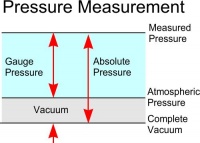Air Pressure
From DT Online
Pressure is measured as the Force per Unit Area. In the case of Atmospheric Pressure at sea level for example, the standard unit of measurement is 1 Bar which is equivalent to 100,000 Newtons of force on each square metre of surface area or, in SI Units, 1 Bar = 100KNm-2 (kilonewtons per square metre). Alternatively, 1 Bar = 100KP, since a Nm2 = a pascal (named after the French inventor Blaise Pascal) or, in Imperial Units, 14.5 pounds per square inch (PSI).

Atmospheric Pressure is an absolute pressure measurement because a perfect vacuum is taken as the zero value
If atmospheric pressure is used as a zero-reference, the pressure measurement is called gauge pressure and is used for pressure measurement of closed systems, such as a tyre pressure or within a pneumatic system.
It follows that absolute pressure is equal to gauge pressure plus Atmospheric Pressure.
Since Pressure is measured as the Force per Unit Area (P=F÷A) then Force equals Pressure x Area.

This can be used to calculate the force exerted by a pneumatic cylinder as follows:
- Force = Pressure x Area
Force produced by cylinder(N) = Pressure(Nmm2) x Area of Piston(mm2)
- But: Area = π x Radius2 = π x Diameter2 ÷ 4
Therefore:
- Force = Pressure x 3.14 x Diameter2 ÷ 4
In practice, losses due to friction, escaping air, etc., mean that the full amount of force calculated will not be available at the output of the piston, or outstroke and on the instroke of a double-acting cylinder, the surface area is reduced because of the piston rod. This means that the compressed air does not have as big an area to push against and so it does not produce as big a force. The resulting surface area, or effective area is found subtracting the area of the piston rod from the surface area of the piston - i.e. Effective area = piston area – piston rod area